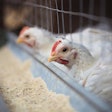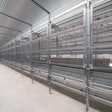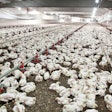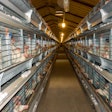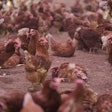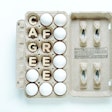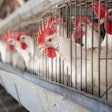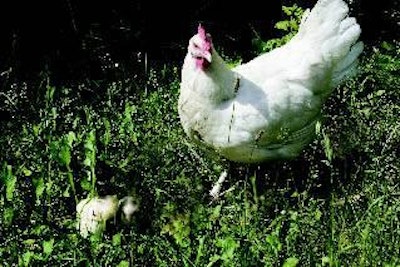
Barrie Wilcox illustrates what many egg producers have done for housing when first investing in cage-free egg production. When the Roy, Wash., producer first went cage-free on part of his production six months ago, "we converted an old layer house that had not been in use for a number of years," Wilcox says.
"We completely remodeled it, taking the old cages out," says the president of Wilcox Farms, whose family has been in the egg business since 1909.
After visiting cage-free operations both in the United States and Europe, Wilcox decided to install a three-level aviary system, which allows the birds to perch, nest, and have access to feed. And because his production is also organic, his laying hens have access to the outside.
Wilcox had been buying and marketing cage-free eggs from other growers, but he says he decided his farm "should walk the talk." Since switching 30,000 birds of his 1.2 million total to cage-free, he says there have been no insurmountable challenges thus far, and says that in his marketing area of the Pacific Northwest, demand is still outpacing supply, and he hopes it stays that way. "We don't want (cage-free, organic eggs) to become a commodity."
Converting Old Houses
On the housing front, Wilcox's example is fairly typical of what egg operationsincluding very large oneshave been doing; converting old egg houses, or unused broiler houses to cage-free production, says Rick VanPuffelen, sales and marketing manager for Chore-Time Egg Production Systems, Milford, Ind.
"There's a significant amount of broiler house conversions to cage-free," VanPuffelen says, which is a low-cost way for producers to enter the business. For the most part, nests for the birds in these remodeled older facilities are placed down the middle on the floor. Farmers will take an old house and put in new nests, new feeding systems, new watering equipment, and new ventilation systems as needed.
One recent example is one of the nation's largest egg farms, in the Midwest, which has converted eight or 10 houses to cage-free by taking out all cages, and put in new slats and a feeding system, plus nests down the middle of the floor, in addition to a scratching area.
VanPuffelen estimates that while aviary systems are popular in Europe, only about 30, such as what Wilcox is using, exist right now in the United States. Their advantage, he says, is that "you can get more birds in the same housing space."
He adds that most cage-free systems are not free range, such as what Wilcox has, however, which "takes a whole new level of management."
"The bar is higher for organics," he adds. VanPuffelen states that all major egg companies have invested in cage-free production, either through their own output, or through purchasing and marketing cage-free eggs from other producers.
New Housing
Erik Draaijer, North American sales manager for Netherlands-based Vencomatic, says that while the first wave of cage-free housing has been the conversion of old housing, that's changing.
"The bigger companies are starting to build new housing," he says, although it does not differ much from other layer housing. Most, whether 40 to 60 feet wide, or 300 to 600 feet long, are regular floor systems, with a nest, roost, and scratching area. Speaking of aviary systems, he says that the rule of thumb is that "you can double bird numbers per house."
Draaijer says that his company's aviary systems are increasing in popularity. He says that 30,000 birds per house is the average flock size of an aviary unit today. And because more birds can fit into a house, he says "the cost is going down per bird with aviary units."
Mimicking Natural Behavior
Draeijer adds that what his company has tried to do is to mimick what the birds look for naturally, so the nests in an aviary unit are similar to a tree.
He agrees that more management is involved in a cage-free system, and animal husbandry is more important, as are issues of light and even heating. One problem he has observed is birds that lay too early in the morning, but this can be solved by having more lighting at the end of the day, so she'll lay later the next day. Draeijer adds that birds will also migrate to different areas of the house if it's too cold.
He adds that most people who switch to cage-free enjoy it: they get to interact more with the birds, and if they do it right, the birds will reward them. In his view, going cage-free "is when the fun begins," because it's more of a challenge.
One difference between the United States and Europe, he says, is that Europe has developed very generous bird space requirements, due to the political environment.
In the end, the consumer will dictate production practices to the egg industry, simply by the choices they make in the supermarket, he says.
Size of Market
How big is the market? VanPuffelen estimates that 4% of eggs produced today are cage-free, and that is likely to grow to 10% within five years.
Wilcox says that the market is growing most rapidly on coasts, such as Seattle, Portland, and San Francisco, while far less rapidly in the nation's heartland. In his market, there is big demand along the coast, but not so in Eastern Washington, which is still largely agricultural.
The biggest change in cage-free, VanPuffelen says, is management: a shift from managing equipment to managing birds, which means houses must be walked a lot more, checking for floor eggs, to see if some nests are not being used, and so forth.
"The expectation is for birds to act like they're caged. Well, they won't. They will have to learn how to find feed and water. In a caged system they went into a cage after 17 weeks and they didn't need a teacher to teach them a whole lot, but under a cage-free system, it's different."
In a cage-free system, for example, the birds may all be huddled up in a corner due to cold drafts in the house. That's where walking the house frequently comes in. Problems such as this need to be identified and corrected soon, or production will decline, he says.
One advantage a collapsible perching system has, VanPuffelen says, is that the perches can be raised as birds grow, but this means paying attention to detail to make sure that the perches are not too high for the birds.
One key to any system of cage-free, he says, is to avoid drafts and to use lighting to draw birds to the nests. Another key, he says, is that bird cannibalism can be a problem; the term pecking order exists for a reason.



